
Visual art of the United States or American art is visual art made in the United States or by U.S. artists. Before colonization there were many flourishing traditions of Native American art, and where the Spanish colonized Spanish Colonial architecture and the accompanying styles in other media were quickly in place. Early colonial art on the East Coast initially relied on artists from Europe, with John White the earliest example. In the late 18th and early 19th centuries, artists primarily painted portraits, and some landscapes in a style based mainly on English painting. Furniture-makers imitating English styles and similar craftsmen were also established in the major cities, but in the English colonies, locally made pottery remained resolutely utilitarian until the 19th century, with fancy products imported.
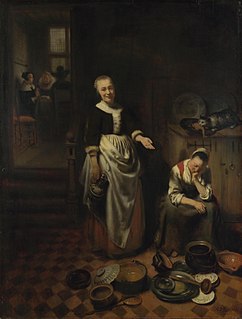
Genre art is the pictorial representation in any of various media of scenes or events from everyday life, such as markets, domestic settings, interiors, parties, inn scenes, and street scenes. Such representations may be realistic, imagined, or romanticized by the artist. Some variations of the term genre art specify the medium or type of visual work, as in genre painting, genre prints, genre photographs, and so on.

Albert Bierstadt was a German-American painter best known for his lavish, sweeping landscapes of the American West. He joined several journeys of the Westward Expansion to paint the scenes. He was not the first artist to record the sites, but he was the foremost painter of them for the remainder of the 19th century.

William Michael Harnett was an Irish-American painter known for his trompe-l'œil still lifes of ordinary objects.

John Frederick Kensett was an American landscape painter and engraver born in Cheshire, Connecticut. A member of the second generation of the Hudson River School of artists, Kensett's signature works are landscape paintings of New England and New York State, whose clear light and serene surfaces celebrate transcendental qualities of nature, and are associated with Luminism. Kensett's early work owed much to the influence of Thomas Cole, but was from the outset distinguished by a preference for cooler colors and an interest in less dramatic topography, favoring restraint in both palette and composition. The work of Kensett's maturity features tranquil scenery depicted with a spare geometry, culminating in series of paintings in which coastal promontories are balanced against glass-smooth water. He was a founder of the Metropolitan Museum of Art.

William Sidney Mount was a 19th-century American genre painter. Born in Setauket in 1807, Mount spent much of his life in his hometown and the adjacent village of Stony Brook, where he painted portraits, landscapes, and scenes inspired by daily life from the 1820s until his death in 1868 at the age of sixty. During that time he achieved fame in the U.S. and Europe as a painter who chronicled rural life on Long Island. He was the first native-born American artist to specialize in genre painting. Mount was also passionate about music and a fiddle player, a composer and collector of songs, and designed and patented several versions of his own violin which he named the "Cradle of Harmony." Many of his paintings also feature musicians and groups of people engaged in dance in rural settings.

Fitz Henry Lane was an American painter and printmaker of a style that would later be called Luminism, for its use of pervasive light.

William James Glackens was an American realist painter and one of the founders of the Ashcan School, which rejected the formal boundaries of artistic beauty laid-down by the conservative National Academy of Design. He is also known for his work in helping Albert C. Barnes to acquire the European paintings that form the nucleus of the famed Barnes Foundation in Philadelphia. His dark-hued, vibrantly painted street scenes and depictions of daily life in pre-WW I New York and Paris first established his reputation as a major artist. His later work was brighter in tone and showed the strong influence of Renoir. During much of his career as a painter, Glackens also worked as an illustrator for newspapers and magazines in Philadelphia and New York City.
Alfred Victor Frankenstein was an art and music critic, author, and professional musician.
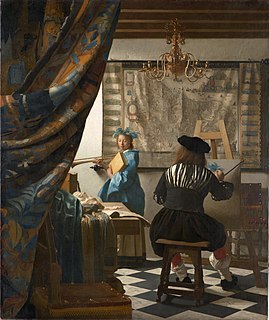
Genre painting, a form of genre art, depicts aspects of everyday life by portraying ordinary people engaged in common activities. One common definition of a genre scene is that it shows figures to whom no identity can be attached either individually or collectively—thus distinguishing petit genre from history paintings and portraits. A work would often be considered as a genre work even if it could be shown that the artist had used a known person—a member of his family, say—as a model. In this case it would depend on whether the work was likely to have been intended by the artist to be perceived as a portrait—sometimes a subjective question. The depictions can be realistic, imagined, or romanticized by the artist. Because of their familiar and frequently sentimental subject matter, genre paintings have often proven popular with the bourgeoisie, or middle class.

The Parrish Art Museum is an art museum designed by Herzog & de Meuron Architects and located in Water Mill, New York, whereto it moved in 2012 from Southampton Village. The museum focuses extensively on work by artists from the artist colony of the South Shore and North Shore.
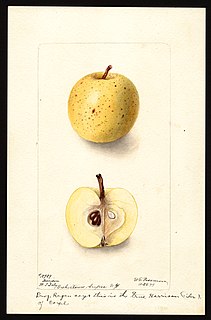
The Harrison cider apple is one of the most famous 18th-century American cider apples, primarily used for the production of apple cider. Grown in New Jersey before and after the American Revolution, it became obsolete by the 20th century. The Harrison cider apple was considered lost until it was recovered in Livingston, New Jersey at an old cider mill in September 1976.

The Long Island Museum of American Art, History, and Carriages, known as the Long Island Museum (LIM), is a nine-acre museum located in Stony Brook, New York. The LIM serves the Long Island community by preserving and displaying its collection of art, historical artifacts, and carriages; providing educational and public programming; and collaborating with a variety of other arts and cultural organizations.
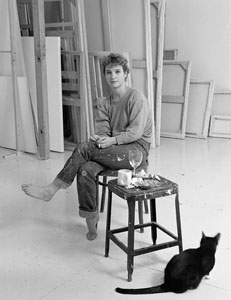
Louisa Lizbeth Chase was an American neo-expressionist painter and printmaker.

William Moore Davis was an American painter best known for his landscapes. A native of Long Island, he spent most of his life near Port Jefferson and has been praised as the greatest painter of that village. A contemporary of the Hudson River School, he was greatly influenced by fellow local painter William Sidney Mount.
The Metropolitan Museum of Art Centennial was a series of events and initiatives celebrating the 100th anniversary of the charter of the Museum occurring between 1969 and 1971.

The Cider Museum is a museum in Hereford, England, about the history of cider. The museum was set up as a Trust in the 1970s by Bertram Bulmer, Norman Weston and the Director of Long Ashton Research Station, John Hudson. They realised that unless a collection was started, then much of the story of cider making would be lost. Initially, the aim was to represent the international history of cider-making, but the majority of the collections have been drawn from England and the West Country.
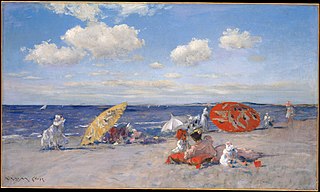
At the Seaside is a late 19th-century painting by American artist William Merritt Chase. Done in oil on canvas, the painting depicts a seaside scene set in Long Island, New York. The work is in the collection of the Metropolitan Museum of Art.
Evelina "Nina" Mount (1837–1920) was a 19th-century American female artist. Born in Stony Brook, New York in 1837, as a daughter of an artist, Evelina was introduced to art at an early age by her father, Henry Mount, and her paternal uncles, Shepard Alonzo Mount and William Sidney Mount, with the latter being her mentor for the first three decades of her life. She is best known for her floral still-lifes and landscapes.

Catania and Mount Etna is a mid 19th century oil sketch by the British artist and poet Edward Lear. Done in oil on board, the work depicts Mount Etna and the surrounding Sicilian countryside near Catania. The drawing is currently in the collection of the Metropolitan Museum of Art in New York City.

















